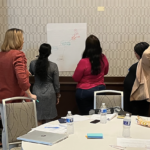Recently, Melissa Fisher asked a Slack community I’m in for ideas on creating successful workshops. Community members who are highly experienced in delivering excellent training and workshops shared some excellent tips, I asked them if I could share them here too. They agreed, so here goes.

Next Level Testing with Lisa Crispin | Functionize
Training from the back of the room
Ahsley Hunsberger was the first to recommend my own favorite resource, Sharon Bowman’s Training from the Back of the Room. (Also known as TBR). This book transformed my ability to turn my workshops into effective learning opportunities for participants. It’s based on science about how our brains work and how we learn. We learn by doing, using our hands, talking with others, moving around the room. We don’t learn much from one person just lecturing us. I personally did not apply all of her techniques. Some of them are things I wouldn’t be comfortable with myself, as a participant. Generally, Bowman’s guidelines have worked so well in my workshops.
Some examples of what I learned to do in workshops, thanks to TBR:
- Limit lecture portions to 5-10 minutes, followed by 15-20 minutes of hands-on activity
- Get people moving. Have table groups work with flip chart paper on the wall, collaborating with sticky notes and markers
- Mix things up, make each exercise a bit different. Have one with table groups, one with people paired up, have groups give each other feedback, get people walking around
The ADDIE model
Jenna Charlton says they love the ADDIE model for developing training. They note that some steps will be less relevant, since in a workshop setting, you haven’t been able to observe and identify the learning needs. Yet, you probably already know what it is, given that these people signed up for your workshop. I wasn’t familiar with this model before. I see lots of useful ideas there that I will try out.
Emphasize activity!
Fiona Charles, who’s been designing and facilitating workshop for decades, shared her expertise. i I’m just going to quote her:
Remember that people in a workshop are there to be participants, not to be an audience. Emphasize activity and keep your talking part to a minimum. Don’t schedule too rigidly and be prepared to abandon what you planned in favour of following the energy in the room. (You can guide it back if participants go too off-topic.) Most important is to remember to allow ample time for debriefing the exercises, to give people a chance to consolidate their learning, share it with everyone, and learn from everyone.
Fiona shared more details in her blog post a few years back, “How to Evaluate a Workshop“. Looking at your own workshop from the perspective of potential participants is helpful!
Be open to fun!
Trish Khoo recalled a particular workshop she facilitated at an Agile Testing Days conference. The helpful organizers asked her if she wanted anything for her session, anything at all. So, she asked for some silly hats. Which they delivered! She was able to work the hats into her workshop, which made it a little more fun. (As an aside, I highly recommend watching the video of Trish’s keynote at ATD 2018). (And for that matter, you can find videos of talks from Fiona, Ashley and Jenna on the AgileTDZone YouTube channel!)
Craft and practice effective exercises
 My own advice to Melissa was this: People are responsible for their own learning. All we can do as facilitators is create to an environment where they can learn. Applying the principles and techniques such as those in Training from the Back of the Room helps us do that. I find that crafting the exercises is the hardest, and most fun, part of creating a workshop. I much prefer doing workshops over talks!
My own advice to Melissa was this: People are responsible for their own learning. All we can do as facilitators is create to an environment where they can learn. Applying the principles and techniques such as those in Training from the Back of the Room helps us do that. I find that crafting the exercises is the hardest, and most fun, part of creating a workshop. I much prefer doing workshops over talks!
Janet Gregory had an important suggestion: Practice the workshop exercises with someone before the conference. She often finds that what she thinks will work, doesn’t, or goes in a different direction than she anticipated. I try to find willing victims on whom I can practice new workshops. Either volunteers where I or my co-facilitator work, or teams at other companies who are willing to spend a lunchtime trying the exercises.
Be sure to get feedback from participants! My pairs and I like to keep it simple. Ask participants to write on an index card – what was most valuable? What was least valuable? And keep tweaking your workshop to make it even better.
Pairing For the Win!
Which brings up my best advice – find someone to pair with to design and facilitate the workshop! When I started out, I did them solo. I soon learned that pairing reduces my stress, is more fun, and provides a much better experience for participants. Since the topic is often my pair’s special expertise, I get to learn a lot about new areas!
For me, facilitating workshops is much less stressful than giving talks! It’s a good feeling at the end of the session to see that at least some people engaged enthusiastically in the exercises and helped each other learn some new stuff.
Many thanks to Melissa, Ashley, Jenna, Fiona, and Trish for offering their ideas to our community and letting me share them!

Leave a Comment